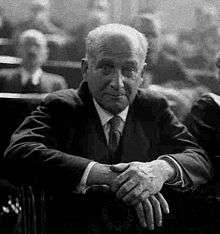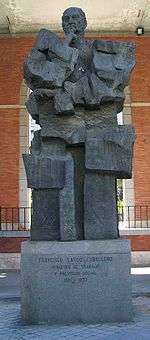Francisco Largo Caballero
| Francisco Largo Caballero | |
|---|---|
 | |
| 66th Prime Minister of Spain | |
|
In office 4 September 1936 – 17 May 1937 | |
| Preceded by | José Giral Pereira |
| Succeeded by | Juan Negrín López |
| Personal details | |
| Born |
15 October 1869 Madrid |
| Died |
23 March 1946 (aged 76) Paris, France |
| Political party | PSOE |
Francisco Largo Caballero (15 October 1869 – 23 March 1946) was a Spanish politician and trade unionist. He was one of the historic leaders of the Spanish Socialist Workers' Party (PSOE) and of the Workers' General Union (UGT). In 1936 and 1937 Caballero served as the Prime Minister of the Second Spanish Republic during the Spanish Civil War.
Biography
Early years
Born in Madrid, as a young man he made his living stuccoing walls. He participated in a construction workers strike in 1890 and joined the PSOE in 1894. Upon the death in 1925 of party founder Pablo Iglesias, he succeeded him as head of the party and of the UGT.[1]
Political career
Moderate in his positions at the beginning of his political life, he advocated maintaining a degree of UGT cooperation with the dictatorial government of General Miguel Primo de Rivera, which permitted the union to continue functioning under his military dictatorship (that lasted from 1923 to 1930).[2] This was the start of his political conflict with Indalecio Prieto, who opposed all collaboration with the dictatorial regime.
He was Minister of Labor Relations between 1931 and 1933, in the first governments of the Second Spanish Republic, headed by Niceto Alcalá-Zamora, and in that of his successor Manuel Azaña.[3] He enjoyed great popularity among the masses of workers, who saw their own austere existences reflected in his way of life.[1]
In the elections of 19 November 1933, the right-wing Spanish Confederation of the Autonomous Right (CEDA) won power in Spain. The government nominally led by the centrist Radical Alejandro Lerroux was dependent on CEDA's parliamentary support. Responding to this reversal of fortune, Largo abandoned his moderate positions, began to talk of "socialist revolution", and became the leader of the left (Marxist and revolutionary) wing of the UGT and the PSOE.[4] In early October 1934, after three CEDA ministers entered the government, he was one of the leaders of the failed armed rising of workers (mainly in Asturias) which was forcefully put down by the CEDA-dominated government.[5]
He defended the pact of alliance with the other workers' political parties and trade unions, such as the Communist Party of Spain (PCE) and the anarchist trade union, the Confederacion Nacional del Trabajo (CNT). Once again, this placed him at odds with Prieto.[6] He declared, that he, Largo Caballero "shall be the second Lenin", whose aim is the union of Iberian Soviet republics.[7]
After the Popular Front won the elections in February 1936, president Manuel Azaña proposed that Prieto join the government, but Largo blocked these attempts at collaboration between PSOE and the Republican government.[8] Largo dismissed fears of a military coup, and predicted that, were it to happen, a general strike would defeat it, opening the door to the workers' revolution.
In the event, the coup attempt by the colonial army and the right came on 17 July 1936. While not immediately successful, further actions by rebellious army units sparked the Spanish Civil War (1936–1939), in which the republic was ultimately defeated and destroyed.
Prime Minister of Spain

On 4 September 1936, a few months into the civil war, Largo Caballero was designated the 134th Prime Minister and Minister of War.[9] Besides conducting the war, he also focused on maintaining military discipline and government authority within the Republic.[10] On 4 November 1936 Largo Caballero persuaded the anarchist Confederación Nacional del Trabajo (CNT; "National Confederation of Labour") to join the government, with four members assigned to junior ministries including Justice, Health and Trade. The decision was controversial with the CNT members.[11]
The Barcelona May Days led to a governmental crisis[12] that forced Caballero to resign on 17 May 1937. Juan Negrín, also a member of the PSOE, was appointed Prime Minister in his stead.[13]
The cabinet, formed on 4 September 1936 and reshuffled on 4 November 1936, consisted of:[14]
| Ministry | Start | End | Officeholder | Party |
|---|---|---|---|---|
| Prime Minister and War | 4 September 1936 | 17 May 1937 | Francisco Largo Caballero | Socialist (left) |
| State (Foreign Affairs) | 4 September 1936 | 17 May 1937 | Julio Álvarez del Vayo | Socialist (left) |
| Finance | 4 September 1936 | 17 May 1937 | Juan Negrín | Socialist (moderate) |
| Interior | 4 September 1936 | 17 May 1937 | Angel Galarza | Socialist (left) |
| Industry and Commerce | 4 September 1936 | 4 November 1936 | Anastasio de Gracia | Socialist (moderate) |
| Industry | 4 November 1936 | 17 May 1937 | Juan Peiró Belis | |
| Commerce | 4 November 1936 | 17 May 1937 | Juan López Sánchez | CNT |
| Navy and Air | 4 September 1936 | 17 May 1937 | Indalecio Prieto | Socialist (moderate) |
| Education and Fine Arts | 4 September 1936 | 17 May 1937 | Jesús Hernández Tomás | Communist |
| Agriculture | 4 September 1936 | 17 May 1937 | Vicente Uribe | Communist |
| Justice | 4 September 1936 | 4 November 1936 | Mariano Ruiz-Funes | Left Republican |
| 4 November 1936 | 17 May 1937 | Juan García Oliver | CNT | |
| Communications and Merchant Marine | 4 September 1936 | 17 May 1937 | Bernardo Giner de los Ríos | Republican Union |
| Labor and Health | 4 September 1936 | 4 November 1936 | José Tomás Piera | Left Republican Party of Catalonia |
| Labor and Planning | 4 November 1936 | 15 May 1937 | Anastasio de Gracia | |
| Health and Social Assistance | 4 November 1936 | 17 May 1937 | Federica Montseny | CNT |
| Public Works | 4 September 1936 | 15 September 1936 | Vicente Uribe (Interim) | |
| 15 September 1936 | 17 May 1937 | Julio Just Gimeno | Left Republican | |
| Propaganda | 4 November 1936 | 17 May 1937 | Carlos Esplá Rizo | |
| Without portfolio | 4 September 1936 | 15 May 1937 | José Giral | Left Republican |
| Without portfolio | 4 September 1936 | 15 May 1937 | Manuel Irujo y Ollo | |
| Without portfolio | 4 November 1936 | 17 May 1936 | Jaume Aiguader | Left Republican Party of Catalonia |
Exile, death, and legacy
Upon the defeat of the Republic in 1939, he fled to France. Arrested during the German occupation of France, he spent most of World War II imprisoned in the Sachsenhausen-Oranienburg concentration camp, until the liberation of the camps at the end of the war.[15]
He died in exile in Paris in 1946;[1] his remains were returned to Madrid in 1978 after Franco's death in 1975.
His son, Francisco Largo Calvo, was imprisoned by the Francoists at the start of the Spanish Civil War and spent the entire war behind bars under the threat of execution. Largo Calvo fled Spain to Mexico in 1949 where he resided until his death in 2001. He is survived by his granddaughter, Sonia Largo Lellis, his great grandsons, Ryan and Chris Lellis, and his great great granddaughter, Riley Lellis.
See also
Footnotes
- 1 2 3 Thomas 2003, p. 39.
- ↑ Beevor 2006, p. 17.
- ↑ Beevor 2006, p. 21.
- ↑ Beevor 2006, p. 28.
- ↑ Beevor 2006, pp. 29–32.
- ↑ Jackson 1967, pp. 206–208.
- ↑ http://www.spartacus.schoolnet.co.uk/SPcaballero.htm
- ↑ Preston 2006, p. 84.
- ↑ Thomas 2003, p. 392–394.
- ↑ Jackson 1967, pp. 341.
- ↑ Paz 2011, p. 96-97.
- ↑ Preston 2006, pp. 256–258.
- ↑ Graham 2005, p. 162.
- ↑ Urquijo y Goitia 2008, p. 129–130.
- ↑ Beevor 2006, p. 413.
Sources
- Beevor, Antony (2006). The Battle for Spain: The Spanish Civil War, 1936–1939. London: Penguin Books. ISBN 0-14-303765-X.
- Graham, Helen (2005). The Spanish Civil War. A Very Short Introduction. Oxford University Press. ISBN 978-0-19-280377-1.
- Jackson, Gabriel (1967). The Spanish Republic and the Civil War, 1931–1939. Princeton: Princeton University Press. ISBN 0-691-00757-8.
- Paz, Abel (2011). The Story of the Iron Column: Militant Anarchism in the Spanish Civil War. AK Press. ISBN 978-1-84935-064-8. Retrieved 2015-08-27.
- Preston, Paul (2006). The Spanish Civil War. Reaction, revolution & revenge. London: Harper Perennial. ISBN 978-0-00-723207-9.
- Thomas, Hugh (2003). The Spanish Civil War. London: Penguin Books. ISBN 978-0-14-101161-5.
- Urquijo y Goitia, José Ramón de (2008). Gobiernos y ministros españoles en la edad contemporánea. Editorial CSIC - CSIC Press. ISBN 978-84-00-08737-1. Retrieved 2015-08-27.
External links
- Documents on Caballero from "Trabajadores: The Spanish Civil War through the eyes of organised labour", a digitised collection of more than 13,000 pages of documents from the archives of the British Trades Union Congress held in the Modern Records Centre, University of Warwick
- Andy Durgan The Rise and Fall of Largo Cabellero, International Socialism, 18 (1983)
- http://www.geneall.net/H/per_page.php?id=467749
| Preceded by José Giral |
Prime Minister of Spain 1936–1937 |
Succeeded by Juan Negrín |